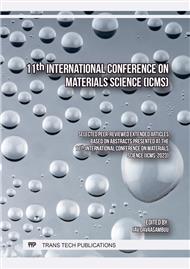[1]
F. Xia, Two-dimensional material nanophotonics, Nat Photon, 8 (2014) 899.
Google Scholar
[2]
L. Cartz, S. R. Srinivasa, R. J. Riedner, Effect of pressure on bonding in black phosphorus, J Chem Phys, 71(1979) 1718.
DOI: 10.1063/1.438523
Google Scholar
[3]
H. Liu, A. T. Neal, Phosphorene: An unexplored 2D semiconductor with a high hole mobility, ACS Nano, 8 (2014) 4033.
DOI: 10.1021/nn501226z
Google Scholar
[4]
J. Qiao, X. Kong, Z. X. Hu, High-mobility transport anisotropy and linear dichroism in few-layer black phosphorus, Nat Commun, 5 (2014) 4475.
DOI: 10.1038/ncomms5475
Google Scholar
[5]
L. Li, Y. Yu, G.J. Ye, Black phosphorus field-effect transistors, Nat Nanotechnol, 9 (2014) 372.
Google Scholar
[6]
V. Tran, R. Soklaski, Y. Liang, Layer-controlled band gap and anisotropic excitons in few-layer black phosphorus, Phys Rev B, 89 (2014) 817.
DOI: 10.1103/physrevb.89.235319
Google Scholar
[7]
X. Wang, A. M. Jones, K. L. Seyler, Highly anisotropic and robust excitons in monolayer black phosphorus, Nat Nanotechnol, 10 (2014) 517.
Google Scholar
[8]
S.P. Koenig, R. A. Doganov, H. Schmidt, Electric field effect in ultrathin black phosphorus, Appl Phys Lett, 104 (2014) 103106.
Google Scholar
[9]
Y.X. Deng, Z. Luo, N.J. Conrad, Black phosphorus monolayer MoS2 van der waals heterojunction p-n diode, ACS Nano, 8 (2014) 8292.
DOI: 10.1021/nn5027388
Google Scholar
[10]
Q. Jiang, L. Xu, N. Chen, Facile synthesis of black phosphorus: an efficient electrocatalyst for the oxygen evolving reaction, Angew. Chem. Int. Ed., 55 (2016) 13849-13853.
DOI: 10.1002/anie.201607393
Google Scholar
[11]
C. Hao, B. Yang, F. Wen, Flexible all-solid-state supercapacitors based on liquid-exfoliated back-phosphorus nanoflakes, Adv Mater, 28 (2016) 3194.
DOI: 10.1002/adma.201505730
Google Scholar
[12]
L. Kong, Z. Qin, G. Xie, Black phosphorus as broadband saturable absorber for pulsed lasers from 1μm to 2.7μm wavelength, Laser Phys Lett, 13 (2016) 045801.
DOI: 10.1088/1612-2011/13/4/045801
Google Scholar
[13]
W. Tao, X. Zhu, X. Yu, Black phosphorus nanosheets as robust delivery platform for cancer theranostics, Adv Mater, 29 (2017) 1603276.
Google Scholar
[14]
Q. Lu, Y. Yu, Q. Ma, 2D Transition-metal-dichalcogenide-nanosheet-based composites for photocatalytic and electrocatalytic hydrogen evolution reactions, Advance Material, 28 (2016) 1917-1933.
DOI: 10.1002/adma.201503270
Google Scholar
[15]
N.R. Khalid, E. Ahmed, Z. Hong, Enhanced photocatalytic activity of graphene–TiO2 composite under visible light irradiation, Current Applied Physics, 13 (2013) 659-663.
DOI: 10.1016/j.cap.2012.11.003
Google Scholar
[16]
S.D. Perera, R.G. Mariano, K. Vu, Hydrothermal synthesis of graphene-TiO2 nanotube composites with enhanced photocatalytic activity, ACS Catalysis, 2 (2012) 949-956.
DOI: 10.1021/cs200621c
Google Scholar
[17]
D. J. Perello, S. H. Chae, S. Song, High-performance N-type black phosphorus transistors with type control via thickness and contact-metal engineering, Nature Communications, 6 (2015) 7809.
DOI: 10.1038/ncomms8809
Google Scholar
[18]
D. O. Scanlon, C. W. Dunnill, J. Buckeridge, Band alignment of rutile and anatase TiO2, Nature Material, 12 (2013) 798-801.
Google Scholar
[19]
H.U. Lee, S. C. Lee, J. Won, Stable semiconductor black phosphorus (BP)@titanium dioxide (TiO2) hybrid photocatalysts, Scientific Report, 5 (2015) 8691.
DOI: 10.1038/srep08691
Google Scholar
[20]
T. Wu, J. Fan, Q. Li, Palladium nanoparticles anchored on anatase titanium dioxide-black phosphorus hybrids with heterointerfaces: highly electroactive and durable catalysts for ethanol electrooxidation, Advanced Energy Materials, 8 (2018) 1701799.
DOI: 10.1002/aenm.201701799
Google Scholar
[21]
X. Li, F. Li, X. Lu, Black phosphorus quantum dots/attapulgite nanocomposite with enhanced photocatalytic performance, Functional Materials Letters, 10 (2017) 1750078.
DOI: 10.1142/s1793604717500783
Google Scholar
[22]
M. Zhu, X. Cai, M. Fujitsuka, Au/La2Ti2O7 nanostructures sensitized with black phosphorous for plasmon-enhanced photocatalytic hydrogen production in visible and near-infrared light, Angewandte Chemie International Edition, 56 (2017) 2064.
DOI: 10.1002/anie.201612315
Google Scholar
[23]
V. Nicolosi, M. Chhowalla, M. G. Kanatzidis, Liquid exfoliation of layered materials, Science, 340 (2013) 1226419.
DOI: 10.1126/science.1226419
Google Scholar
[24]
X. Huang, Z. Zeng, H. Zhang, Metal dichalcogenide nanosheets: preparation, properties and Applications, Chemical Society Reviews, 42 (2013) 1934-1946.
DOI: 10.1039/c2cs35387c
Google Scholar
[25]
Q. H. Wang, K. Kalantar-Zadeh, A. Kis, Electronics and optoelectronics of two-dimensional transition metal dichalcogenides , Nature nanotechnology, 7 (2012) 699-712.
DOI: 10.1038/nnano.2012.193
Google Scholar
[26]
T. Bao, T. Ojiyed, Hasichaolu, J. Ning, Narengerile, Preparation of black phosphorus by the mechanical ball milling method and its characterization, Solid state phenomena, 271 (2018) 18-22.
DOI: 10.4028/www.scientific.net/ssp.271.18
Google Scholar
[27]
T. Bao, A. Bolag, X. Tian, T. Ojiyed, Synthesis of black phosphorene/P-rich transition metal phosphide NiP3 heterostructure and its effect on the stabilization of black phosphorene, Crystals, 13 (2023) 1571.
DOI: 10.3390/cryst13111571
Google Scholar
[28]
H. P. Klug, L. E. Alexander. X-ray diffraction procedures for poly-crystalline and amorphous materials[M]. NewYork : Willey, 1974.
Google Scholar
[29]
V. Tran, R. Soklaski, Y. Liang, L. Yang, Layer-controlled band gap and anisotropic excitons in few-layer black phosphorus. Phys. Rev. B, 89 (2014) 235319-1-6.
DOI: 10.1103/physrevb.89.235319
Google Scholar
[30]
G. W. Zhang, S. Y. Huang, A. Chaves, C. Y. Song, V. Ongun Özçelik, T. Low, H. G. Yan, Infrared fingerprints of few-layer black phosphorus. Nat. Commun. 8 (2017) 14071-1-9.
DOI: 10.1038/ncomms14071
Google Scholar
[31]
P.Yasaei, B. Kumar, T. Foroozan, C. H. Wang, M. Asadi, D. Tuschel, J. Ernesto Indacochea, R. F. Klie, A. Salehi-Khojin, High-quality black phosphorus atomic layers by liquid-phase exfoliation. Adv. Mater. 27 (2015) 1887-1892.
DOI: 10.1002/adma.201405150
Google Scholar



